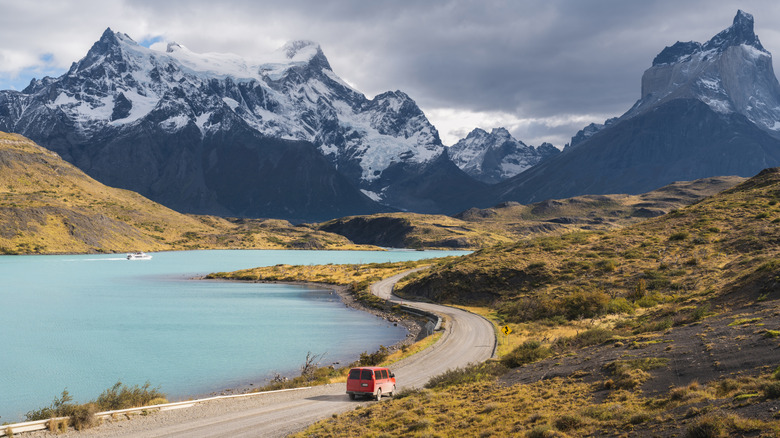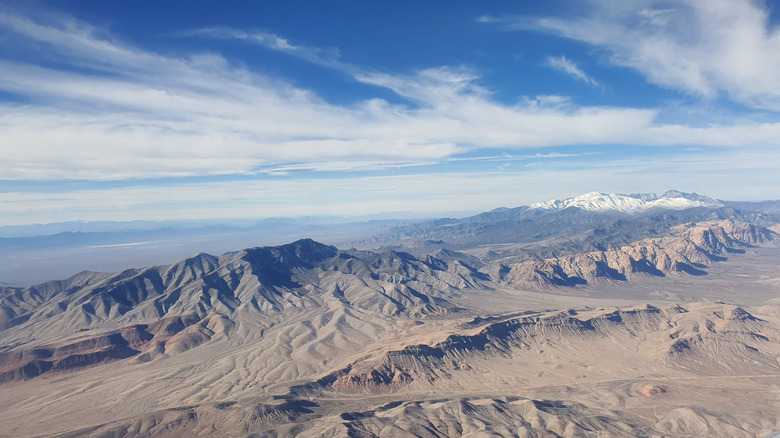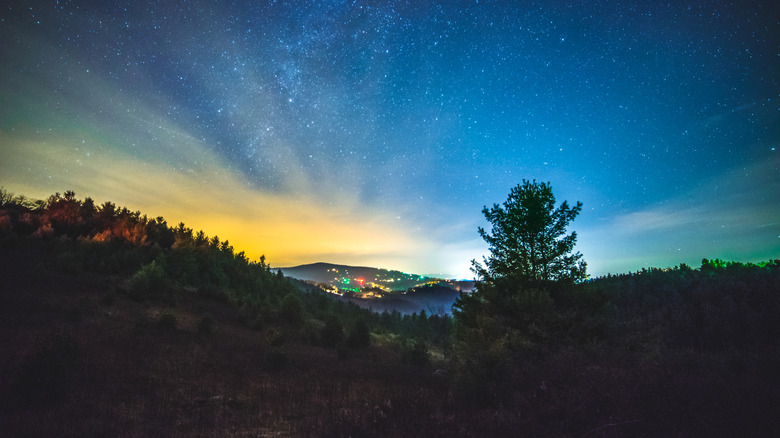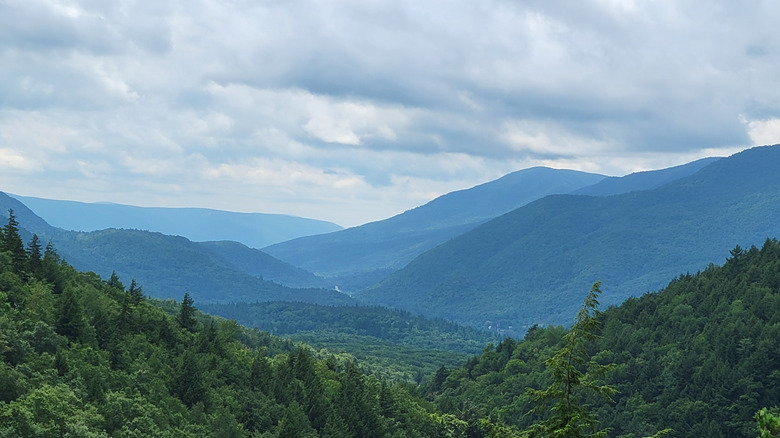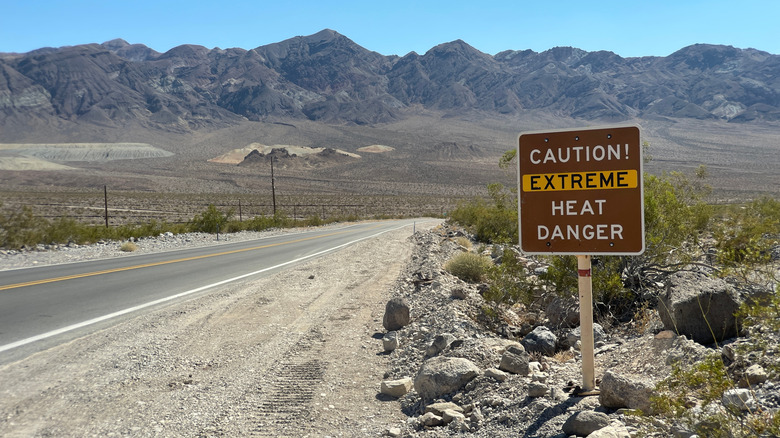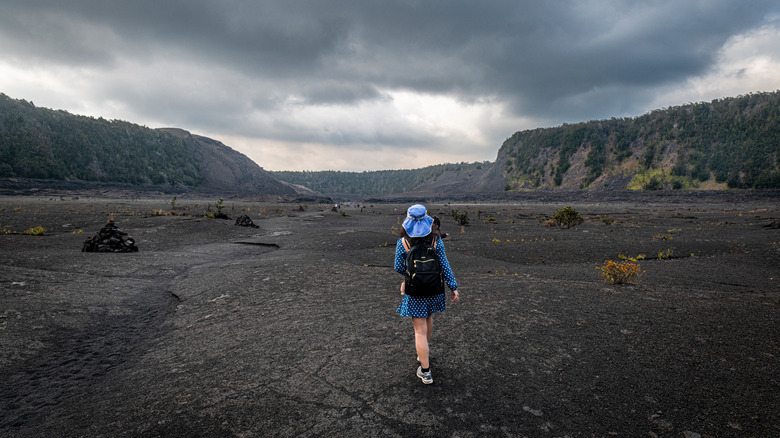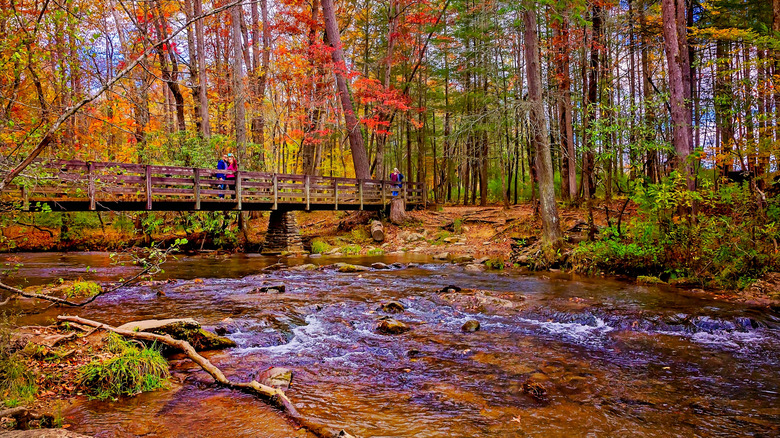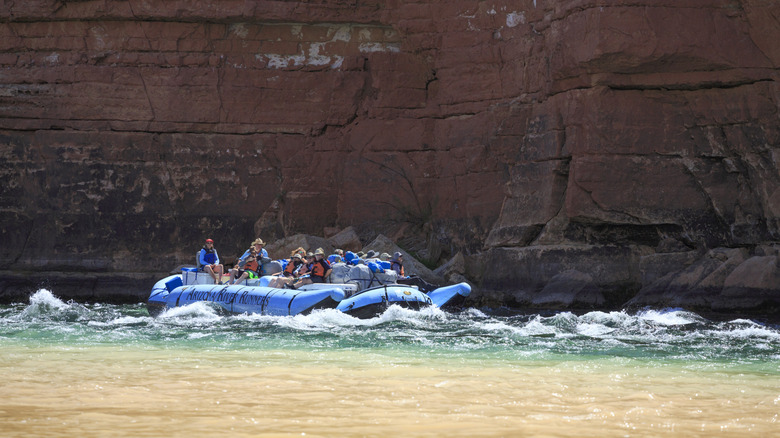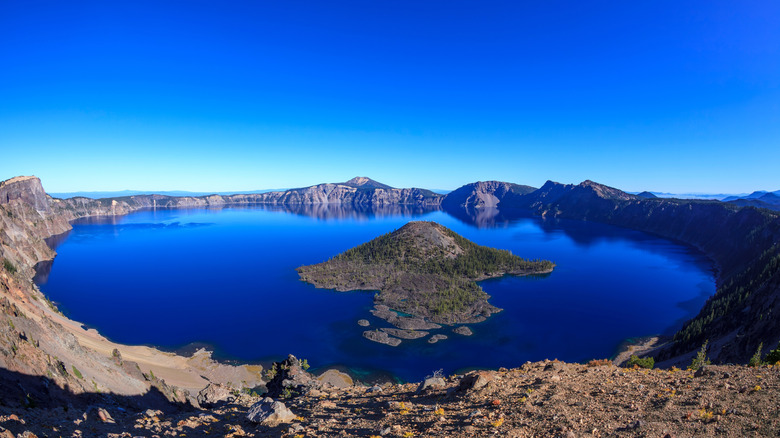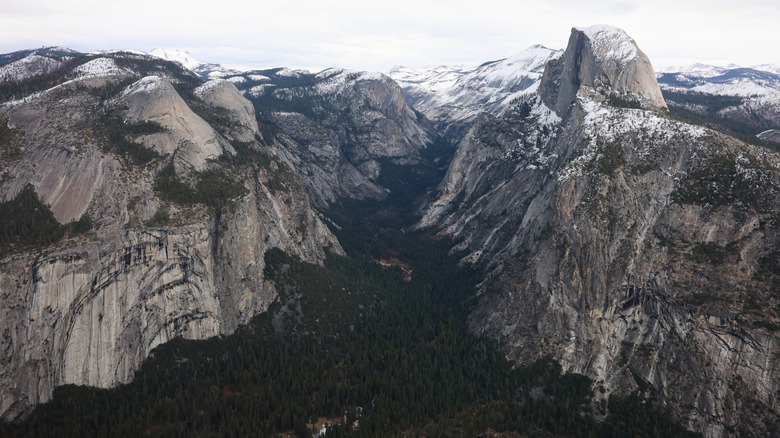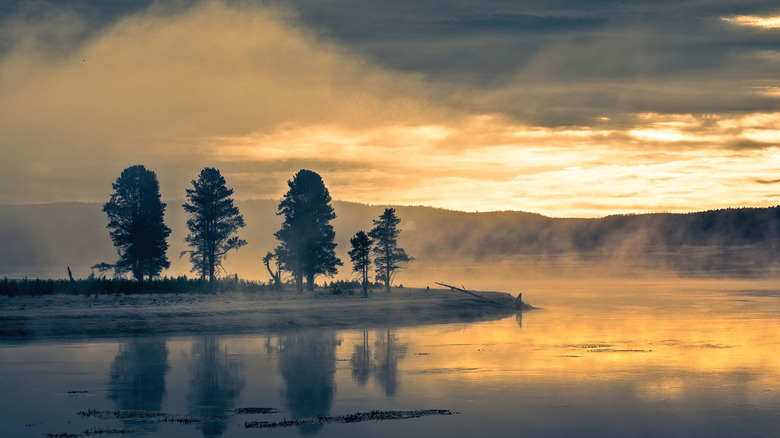Unsettling Unsolved Mysteries That Still Haunt Our National Parks To This Day
America's national parks have a consistent theme of beauty, untrammeled majesty, and a welcoming environment that caters to all manner of visitors. National parks feature some of the country's most difficult hikes, as well as hiking trails with accessible features. Camping is a big draw for visitors, as are other outdoor pursuits that bring people closer to nature and the wildlife that calls these phenomenal locations home (see: wildlife tips from the National Park Service).
But it's not all sunshine and roses within the sprawling wildernesses of national parklands. A 50-square-mile area in Yellowstone National Park has been ominously dubbed the "Zone of Death." Here, a person could theoretically get away with murder on a jury selection technicality, as a result of the segment's complex jurisdiction overlaps and lack of residents. This lawless scenario remains hypothetical, but there are sadly a great number of deaths, disappearances, and other tragedies and oddities that have taken place in national parks. Some are straightforward criminal activities, while others remain a mystery long after the event occurred. These are some of the most striking mysteries that have occurred within the nation's national parks.
Kenny Veach went missing in Desert National Wildlife Refuge
A longtime hiker with plenty of experience in the backcountry disappeared under mysterious circumstances in late 2014. Kenny Veach was no stranger to the deserts surrounding Las Vegas. He had been hiking and spelunking for years, and in 2014 recounted an adventure that brought him to an M-shaped cave unlike any he had seen before. Veach recalled that stepping through the entrance brought on a strange, vibrating sensation throughout his body. He left the cave without exploring it further, but vowed to seek it out again in the future.
Veach posted a video to YouTube in October 2014 that begins with him standing next to a boarded-up mine shaft. He wasn't able to locate the cave during that trip, and undertook the exploration one more time. This next adventure, in November, would be his last. Veach disappeared, and only his cell phone was recovered — at the same mine shaft he had filmed the penultimate video.
Conspiracy theories quickly took root, with some assuming he had stumbled onto a dangerous government secret (since the Nellis Air Force Base and Area 51 are nearby). Others suggested alien involvement, while a woman claiming to be his girlfriend posted a lengthy note on his video suggesting a lost battle with his mental health. Even as an experienced hiker, it's possible that he simply succumbed to the harsh desert environment. The mystery will seemingly continue, however, since no trace of Veach has ever been uncovered.
Pisgah National Forest's Brown Mountain Lights
Set within the Blue Ridge Mountains and a bit north of Asheville, NC, Pisgah National Forest is a historic landscape and a gem within an already gorgeous swath of natural scenery. The forest comprises hundreds of miles of hiking trails and was part of the first purchases that ultimately led to the establishment of national forestlands in the region. It's also home to a surprising phenomenon that was first documented more than a century ago but remains unexplained.
Viewers report seeing orbs of light that float around Brown Mountain. Sometimes they're described as multi-colored, other times they appear like stars. They've also been depicted as bouncing around or floating silently in place above the ridge. The mystery of the Brown Mountain Lights goes even deeper, with one viewer even suggesting that he followed them into a cave and came face-to-face with aliens!
An early explanation from a USGS geologist suggested this oddity was created by car and train lights in the distance. But that explanation hasn't held up, and researchers are still baffled by the presence of these lights. They were captured on video by National Geographic in 2010, showing that their appearance has been persistent, even with changes in the way humans move about the nearby landscape. Of course, some of the most exciting explanations veer into the paranormal. It's thought that the lights could be the spirits of ancient Native American warriors who once fought a battle here, or those of Civil War soldiers.
The 'Bennington Triangle' and Paula Jean Welden's Disappearance
Tucked in near the bottom of the Green Mountains in Vermont is Bennington County. The area is the dreamy landscape you'd expect of an outdoor enthusiast's ideal getaway. Green Mountain National Forest dominates the northern part of the county's largely rectangular boundaries. In the area and its surroundings, travelers will find an abundance of excellent fall foliage and plenty of quiet places to sit with their thoughts. One particular thought that may come to mind for those exploring the area involves a local mystery, albeit one that residents don't spend too much time indulging in.
The "Bennington Triangle" is a term coined many years after the phenomenon it sought to explain. In 1992, Joseph Citro suggested the moniker, leaning into the longstanding supernatural characteristics of the region. The Bennington Monster has been sighted in the area since the early 1800s. The place is also thought to be the subject of a curse dating back to Native American legend.
Quite recently, the triangle served as the backdrop for five disappearances between 1945 and 1950. Most famously, Paula Jean Welden disappeared while hiking in the forest in 1946. She wasn't found, and the need for police resources from Massachusetts, Connecticut, and New York to intervene in the search eventually led to the creation of Vermont's state police force.
Death Valley's missing German tourists
In 1996, a family of four from Germany went missing in Death Valley. The tourists, dubbed the "Death Valley Germans." had an exciting adventure planned around Los Angeles, Las Vegas, and more. A stop in Death Valley National Park was part of their itinerary, delivering a great opportunity to get out in the California wilderness on their way to explore Yosemite to the north. Death Valley National Park is the lowest, hottest, and driest national park in the U.S.
The family was traveling in a rented minivan, and their error seemingly boils down to a decision to cut across the park on backcountry roads rather than turn around to drive along the highways. The van was eventually found stuck in the sand with flat tires and clear signs of failure, but there was no trace of the visitors. However, skeletal remains found 13 years later may be conclusive evidence that the family had indeed succumbed to the elements. After stopping at a waypoint known as the Geologist's Cabin, they moved farther into the cauldron of heat and desert sand. It appears that they eventually turned around and tried to return, but to no avail.
Arman B. Johnson's murder in Hawai'i Volcanoes National Park
Many mysteries that occur in national parks involve disappearances or the unstoppable force of Earth's vengeful elements. Falling off cliffs, getting lost in the woods or desert, or being hurt in an encounter with local wildlife is possible here, especially for those who travel off-trail. Another sort of mystery can take place, though; in Hawai'i, a shocking example of this nature occurred in 2005. Arman B. Johnson, a 44-year-old transplant from Seattle (dating back to the '80s), was found near the southern edge of Hawai'i Volcanoes National Park in April. Johnson was the victim of a single gunshot to the back of his neck. Authorities believed he had been killed where his body was found.
These threads of evidence are the only contextualizing details that investigators were ever able to piece together. No one has come forward with new information, and no additional breakthroughs or theories have been put forward either. The case has gone decidedly cold, and with this dead end has come a cloud of darkness. This is because it's rare for people to be murdered in national parks, even with roughly 240 deaths taking place within them in an average year.
The disappearance of the Patriot and its famous passenger, Theodosia Burr Alston
One mystery that plays directly into the wheelhouse of history buffs involves one of America's early names. Audiences today will know the name "Burr," not because they read about the founding father in a history textbook, but because Lin-Manuel Miranda revolutionized his legacy alongside that of Alexander Hamilton on the Broadway stage. Aaron Burr's contribution to U.S. history is depicted in immense detail within the confines of the play. However, something that's left out of his story is a tragic loss off the coast of North Carolina's Outer Banks.
Theodosia Burr Alston was Aaron Burr's daughter and was lost at sea in a mysterious disappearance that took an entire ship along with it. The Patriot was a schooner that left Georgetown in 1812 and vanished along its route. Conspiracy was rife 200 years ago, as it remains today, and plenty of wild theories were flung around about how she had been captured by pirates and made to be the mistress of an abductor in Bermuda.
Other theories suggested that she had been made to walk the plank during a raid on the ship or even killed while fighting off seaborne interlopers. Most likely, the vessel foundered off this particularly treacherous stretch of coastline during a storm. It's even documented that bad weather scattered British ships in the vicinity the day after her departure. However, this hasn't stopped theories from forming over the famous disappearance.
Dennis Martin disappeared in Great Smoky Mountains National Park
Hikers sadly go missing in national parks on a not-infrequent basis. But there's a particular subset of disappearances that are grueling for family members and onlookers from the public. Park visitors like Dennis Martin enjoy a special place in the hearts of those who read about the tragic stories recounting their vanishings. Martin was almost 7 at the time of his disappearance, weighing about 55 pounds and standing a squat 4 feet tall. In 1969, he vanished during a Father's Day weekend trip with his family to the Great Smoky Mountains National Park.
The group was hiking along the Appalachian Trail (check out a first-timer's guide), and the last time Martin was seen was while the younger ones played hide and seek. The boys attempted to sneak up on the adults as they sat in a field, but Martin never emerged from the brush. The resulting search was one of the largest in the history of the National Park Service, but it never turned up even a trail of where the boy had gone. Severe rains overnight certainly didn't help. The 2,000 or more people who participated in the search ultimately came up empty-handed, leaving Martin's fate to remain unknown.
Glen and Bessie Hyde vanished while rafting the Grand Canyon
One bizarre mystery of a national park disappearance took place nearly 100 years ago. Rather than a lost hiker or the victim of foul play, Glen and Bessie Hyde are believed to have run away! The couple set off on a boating adventure through the Green and Colorado Rivers on their honeymoon trip in 1928, eventually passing through the Grand Canyon along their route. After roughly a month on the water, they stopped to rest at Grand Canyon Village for a short time, where they spoke with a reporter from the Denver Post. According to the Los Angeles Times, Bessie is said to have exclaimed, "I wonder if I'll ever wear pretty shoes again," while admiring the footwear of a nearby girl.
Later, the couple's vessel was found intact and floating along the shore. Their supplies were largely unharmed, and there were no signs of any issue, aside from the fact that the pair had disappeared. Rescuers never found any sign of them in the surrounding landscape; however, a woman appeared along the river many years later, claiming to be Bessie. It's also thought that a well-known Grand Canyon adventurer named Georgie Clark was Bessie hiding in plain sight.
A catalog of oddities at Crater Lake National Park
Crater Lake National Park is a gem. The Oregon icon is home to America's deepest lake, the result of an ancient volcanic eruption that decimated Mount Mazama (the feature that formerly stood where the deep blue void now fills). The lake has an average depth of 1,148 feet, making it immensely large and, therefore, exceedingly cold. The park is home to a number of unusual quirks. There's a log known as the "Old Man of the Lake" that's roughly 30 feet tall and has floated around the water body for upwards of 100 years, vertically. In 1988, researchers secured the fallen tree (dated to about 450 years old) while piloting a submarine in the depths. The weather became volatile, only to let up once the relic was released to continue its meandering float.
Adding to the mystique, Mount Mazama is considered the sacred mountain of creation by one of the area's original inhabitants, the Klamath. The group signed a treaty with the U.S. government in 1864, naming Crater Lake ("Giiwas") as their territory, only to have the land turned into a national park within a half century. One final mystery in Crater Lake is that of Wizard Island. One of the land segments that rises out of the lake, the island looks like a wizard's hat and can even be seen with fog collecting around its rising figure. Park rangers swear they've seen what appear to be fires and human figures on the island in the depths of night, only to discover nothing when investigating further.
Yosemite's cursed Tenaya Canyon
Tenaya Canyon has a magnetic appeal. It's a steep decline from Tenaya Lake down into the Yosemite Valley, and free from trailheads or other assistive buildup. The area was named after an Indigenous leader, Chief Tenaya, and it's thought that the landscape is cursed as a result of the poor treatment that its native people endured at the hands of newly arrived settlers. On a practical, geological note, the cliff face is treacherous to say the least. It features a 4,000-foot drop down into the valley below, with smooth, slippery granite rock faces exposed throughout its descent. Waterways cut their path through the gorge, and to successfully navigate the obstacles, you'll need to rappel in certain areas.
This part of Yosemite National Park has been the site of so many accidents, injuries, and deaths that it's been dubbed the "Bermuda Triangle of Yosemite." Returning to the lore of the site, it's easy to see why such a troubling pall would be placed over the otherwise awe-inspiring landscape. It's the historical site of at least one battle during the Mariposa Indian War that took place after the arrival of white settlers. The last known chief of the local population (the Ahwahneechee people) was Tenaya, whose son was killed in the battle. His continued presence seemingly looms large over the valley, whether in curse form or simply as a reminder of the land's long history.
Yellowstone Lake's mysterious singing
A mystery is only as good as its back story. Those lacking legendary tales in the modern catalog of the occult don't capture the imagination in quite the same way. In the 19th century, Captain Hiram Chittenden worked as an engineer in Yellowstone National Park and documented a peculiarity he encountered while out and about. He wasn't the first to experience (or document) the occurrence, but his account is particularly striking. Yellowstone Lake, it would seem, has a tendency to sing to its visitors, especially during the winter months. No one knows what causes the phenomenon, even roughly 150 years after its first report. As Chittenden once noted, "I like to imagine there's a mystical creature that lives in the depths of Yellowstone Lake calling out a lonely song," (via Thrillist).
The phenomenon isn't contained to the annals of history. Recent park employees have noted their experience with the lake's tendency to sing, and perhaps surprisingly, it lets out a variety of different sonic palettes. The lake has produced mechanical pounding sounds, as if it were reflecting the whirr of a jet engine. It's something more akin to the deep, majestic call of a whale or the cold but reassuring pings of a sonar bounce.
